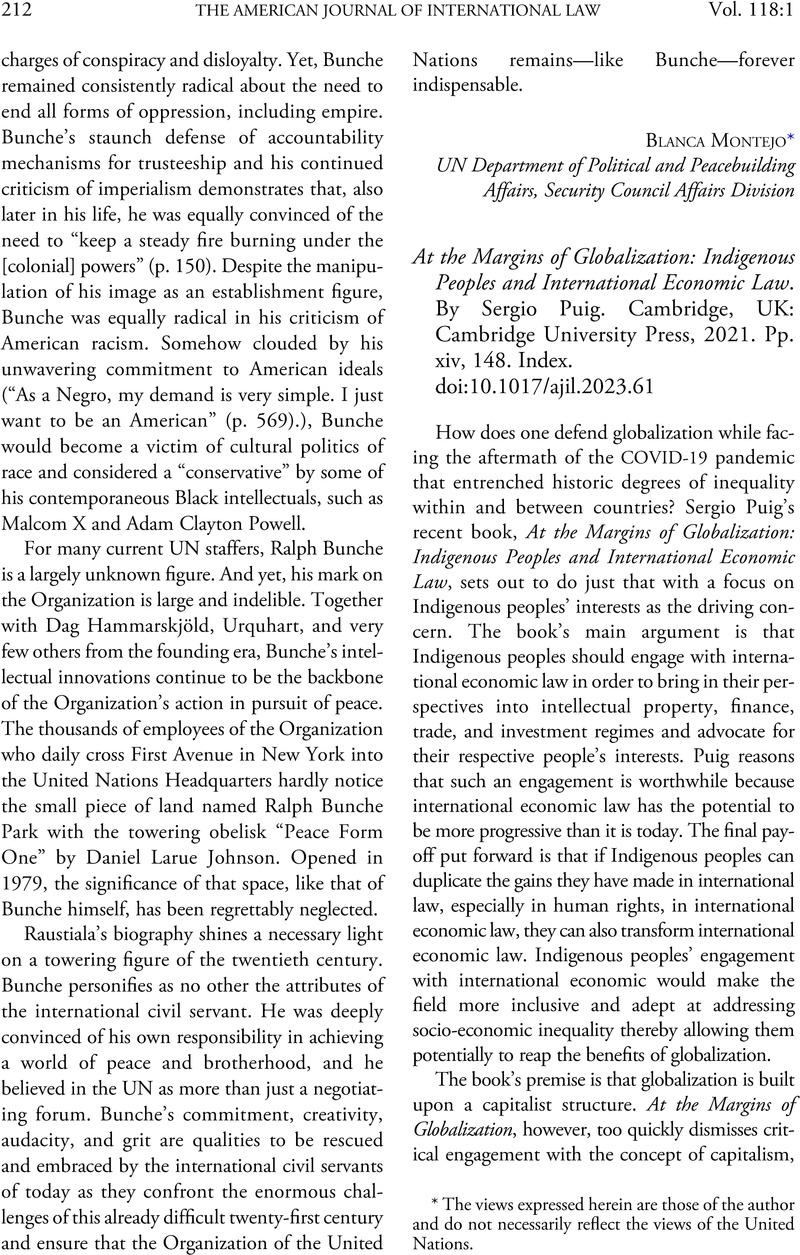No CrossRef data available.
Published online by Cambridge University Press: 29 January 2024

1 See, e.g., Victor Menotti, How the World Trade Organization Diminishes Native Sovereignty, in Paradigm Wars: Indigenous Peoples’ Resistance to Globalization (Jerry Mander & Victoria Tauli-Corpuz eds., 2006); Valentina Vadi, Global v. Local: The Protection of Indigenous Heritage in International Economic Law, in Indigenous Rights: Changes and Challenges for the Twenty-First Century (Sarah Sargent & Jo Samanta eds., 2016).
2 GA Res. 61/295 (Oct. 2, 2007).
3 Roxanne Dunbar-Ortiz, How Indigenous Peoples Wound Up at the United Nations, in The Hidden 1970s (Dan Berger ed., 2010).
4 FPIC is also articulated in ILO Convention 169 and the Convention on Biological Diversity.
5 Priscilla Claeys & Edelman, Marc, The United Nations Declaration on the Rights of Peasants and Other People Working in Rural Areas, 47 J. Peasant Stud. 1, 22 (2020)Google Scholar.
6 GA Res. 73/165 (Jan. 21, 2019).
7 Puig, Sergio, International Indigenous Economic Law, 52 U.C. Davis L. Rev. 1243 (2019)Google Scholar; see also Indigenous Peoples and International Trade: Building Equitable and Inclusive International Trade and Investment Agreements (John Borrows & Risa Schwartz eds., 2020).
8 Since this book is an important reference, it is unfortunate that several times throughout the book, scholars are quoted in the text but without citation. The inclusion of a bibliography would also have been helpful.
9 Appellate Body Report, European Communities—Measures Prohibiting the Importation and Marketing of Seal Products, WTO Docs. WT/DS400/AB/R and WT/DS401/AB/R (May 22, 2014).
10 Michael Fakhri & Madeline Redfern, How the WTO Constructed Inuit and Indigenous Identity in EC-Seal Products, in Indigenous Peoples and International Trade, supra note 7.
11 Fakhri, Michael, Markets, Sovereignty, and Racialization, 25 J. Int'l Econ. L. 242 (2022)CrossRefGoogle Scholar.
12 European Commission, On the implementation of Regulation (EC) No. 1007/2009, as amended by Regulation (EU) 2015/1775, on the Trade in Seal Products, at 17 (Jan. 10, 2020), at https://ec.europa.eu/transparency/expert-groups-register/core/api/front/document/38257/download.
13 See, e.g., Chimni, B.S., Capitalism, Imperialism, and International Law in the Twenty-First Century, 14 Ore. Rev. Int'l L. 17 (2012)Google Scholar; Knox, Robert, Civilizing Interventions? Race, War and International Law, 26 Camb. Rev. Int'l Aff. 111 (2013)Google Scholar; Rose Parfitt, The Process of International Legal Reproduction: Inequality, Historiography, Resistance (2019); Ntina Tzouvala, Capitalism as Civilisation: A History of International Law (2020); Gathii, James Thuo & Tzouvala, Ntina, Racial Capitalism and International Economic Law: Introduction, 25 J. Int'l Econ. L. 199 (2022)CrossRefGoogle Scholar.
14 Baxi, Upendra, Globalisation: Human Rights Amidst Risk and Regression, 32 IDS Bulletin 94 (2001)Google Scholar.
15 Alston, Philip, Resisting the Merger and Acquisition of Human Rights by Trade Law: A Reply to Petersmann, 13 Eur. J. Int'l L. 815 (2002)CrossRefGoogle Scholar.
16 Kate Miles, The Origins of International Investment Law: Empire, Environment, and the Safeguarding of Capital 195–96 (2013).
17 For example, this was Madeline Redfern's position in Fakhri & Redfern, supra note 10, at 114.
18 Glen Coulthard & Voices Rising, For Our Nations to Live, Capitalism Must Die, Unsettling America: Decolonization in Theory & Practice (Nov. 5, 2013), at https://unsettlingamerica.wordpress.com/2013/11/05/for-our-nations-to-live-capitalism-must-die.
19 John Borrows, Indigenous Diversities in International Investment and Trade, in Indigenous Peoples and International Trade, supra note 7.
20 See, e.g., Glen Sean Coulthard, Red Skin, White Masks: Rejecting the Colonial Politics of Recognition (2014); Robin Wall Kimmerer, Braiding Sweetgrass: Indigenous Wisdom, Scientific Knowledge and the Teachings of Plants (2015); Nick Estes, Our History Is the Future: Standing Rock Versus the Dakota Access Pipeline, and the Long Tradition of Indigenous Resistance (2019); Patty Krawec, Becoming Kin: An Indigenous Call to Unforgetting the Past and Reimagining Our Future (2022).
21 Note 13 supra.
22 Dunbar-Ortiz, supra note 3.